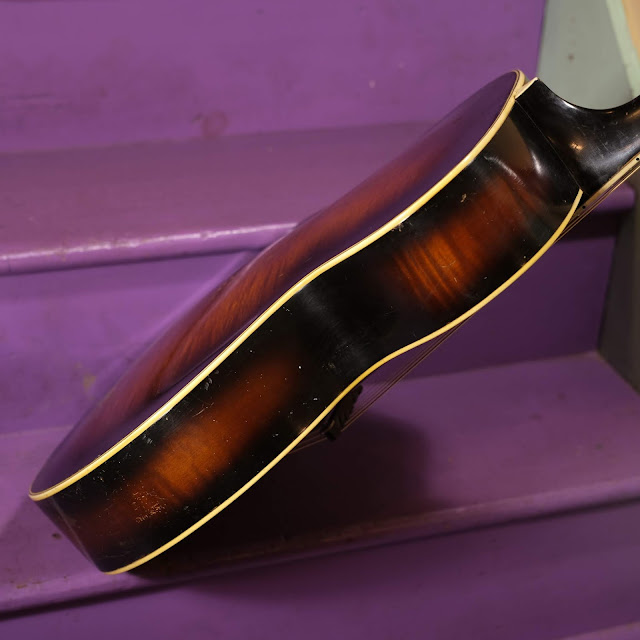1930s Harmony-made Broman Challenger Archtop Guitar
A local fellow has been coming in the shop for a couple months now, trying to figure-out what type of archtop he wanted to get for himself. He wanted bling and good tone but he also didn't want to be paying a king's ransom for bling on an old Gibson or Epiphone. After trying all sorts of archtops in the shop, he checked-out what was in the back room awaiting repair and this guy was in there and he was excited about it.
As it's a consignment guitar, I told him I'd put it in line with the rest of that consignor's gear and let him know when it was done. Initially I'd said I could have it ready for him sometime shortly after our holiday break, but I had some extra hours over the last couple of days and so I managed to get the work done for him just in time for him to check it out and see if he wanted to bring it home. He did! Another happy repatriation, eh?
These higher-grade Harmony archtop builds are always satisfying. They look good, have fancy appointments (check out all that big-block pearl on the fretboard and the center-stripe down the board, too), and tend to have great voicing, too. This one has a chunky, mids-forward, punchy sound that reminds me a bit of an Epiphone from the '30s crossed with a Gibson Kalamazoo archtop. It's got a good warmth when you pick near the fretboard extension but has a lot of guts in the middle if you want to pick lead on it.
Repairs included: a neck reset, fretboard plane and refret with medium stock, cleaning, replacement tuners, fitting of a new adjustable rosewood bridge, and setup.
Setup notes: the neck is straight and it plays perfectly with 3/32" EA and 1/16" DGBE action at the 12th fret, strung with 54w, 40w, 30w, 22w, 16, 12 gauges. I think 11s would be an even better choice if it's just being chorded, but the heavier bottom and top of this set gives it good mwah when dug-into.
Scale length: 25"
Nut width: 1 3/4"
String spacing at nut: 1 1/2"
String spacing at bridge: 2 1/8"
Body length: 19 7/8"
Lower bout width: 15 3/8"
Waist width: 8 7/8"
Upper bout width: 11"
Side depth at endpin: 3 1/2"
Top wood: solid spruce
Back/sides wood: solid figured maple
Neck wood: two-piece maple
Bracing type: tonebar
Fretboard: Brazilian rosewood, bone nut
Bridge: Indian rosewood, adjustable
Neck feel: med-big V shape, 10" board radius
Condition notes: unoriginal tuners, bridge, and frets, but otherwise all-original and in good order. It has no cracks which is amazing for an old Harmony-made archtop.
The celluloid headstock veneer looks killer. This headstock shape is seen on tons of old Harmony makes including their own Harmony Monterey models, Marwin-branded models, SS Stewart-branded models, and many other names. The features of this guitar date it to the late '30s.
That fretboard is awesome, right? I love the big-block pearl and center-stripe down the board.
It's surprising to see an original tailpiece intact!
While there's plenty of usewear throughout the finish, the guitar itself is in quite good shape.
The new tuners are StewMac Golden Age repro-style units with an antiqued finish.
Interestingly, though the neck is maple, the "flame" figure on its rear is faux-flame.
The figured maple on the back is pretty stuff, no?





















Comments